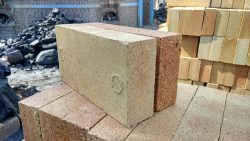How Do Fire Bricks Work?
 How Do Fire Bricks Work?
How Do Fire Bricks Work?
If you have a wood-burning stove or fireplace, you may have heard of fire bricks. Fire bricks are specially designed bricks that are used to line the inside of a stove or fireplace to improve its efficiency and durability. But how do fire bricks work, and why are they so important? In this post, we’ll take a closer look at fire bricks to answer these questions and more.
What Are Fire Bricks?
Fire bricks, also known as refractory bricks, are high-temperature bricks made of refractory ceramic materials. Refractory materials are materials that are able to withstand high temperatures without melting or deforming. Fire bricks are designed to be used in fireplaces, stoves, kilns, furnaces, and other high-temperature environments.
How Do Fire Bricks Work?
Fire bricks work by absorbing heat from the fire and then releasing it slowly over time. When you burn wood in a fireplace or stove, the bricks absorb the heat from the fire and then release it back into the room as the bricks cool down. This helps to keep the room warm even after the fire has gone out.
Fire bricks also help to protect the fireplace or stove from the intense heat of the fire. When wood is burned, it can reach temperatures of up to 1,100 degrees Celsius (2,012 degrees Fahrenheit). This heat can cause damage to the inside of your stove or fireplace, which can be expensive and time-consuming to repair. Fire bricks provide a layer of insulation to protect the stove or fireplace from the heat of the fire.
Types of Fire Bricks
There are several types of fire bricks available, and each type has its own specific properties that make it ideal for different applications.
1. Clay Fire Bricks
Clay fire bricks are made from clay and are the most common type of fire brick. They are durable, lightweight, and easy to install. They are ideal for use in residential fireplaces and stoves.
2. Insulating Fire Bricks
Insulating fire bricks are made from lightweight materials such as vermiculite, perlite, or refractory foam. They have a low thermal conductivity, which means they are able to insulate against high temperatures. They are ideal for use in kilns, furnaces, and other high-temperature applications.
3. Silicon Carbide Fire Bricks
Silicon carbide fire bricks are made from silicon carbide and are extremely durable. They can withstand temperatures of up to 1,800 degrees Celsius (3,272 degrees Fahrenheit) and are ideal for use in industrial kilns and furnaces.
4. Refractory Fire Bricks
Refractory fire bricks are made from high-density materials such as alumina, silica, and magnesia. They have a high thermal conductivity, which makes them ideal for use in industrial applications such as steel production and glass manufacturing.
Benefits of Fire Bricks
There are several benefits to using fire bricks in your fireplace or stove.
1. Improved Efficiency
Fire bricks help to improve the efficiency of your fireplace or stove by absorbing heat from the fire and then releasing it slowly over time. This helps to keep your home warm for longer periods of time and reduces the amount of wood you need to burn.
2. Protection from High Temperatures
Fire bricks provide a layer of insulation to protect your fireplace or stove from the intense heat of the fire. This helps to prevent damage to the inside of your stove or fireplace and reduces the risk of fire.
3. Durability
Fire bricks are durable and long-lasting. They can withstand high temperatures without melting or deforming, which means they require less maintenance and have a longer lifespan than other materials.
Conclusion
Fire bricks are an essential component of any fireplace or stove. They help to improve the efficiency of your heating system, protect it from high temperatures, and are durable and long-lasting. Whether you’re using your fireplace to warm your home or heating an industrial kiln, fire bricks are an important investment that will provide long-lasting benefits.
Categorised in: Fire Bricks
